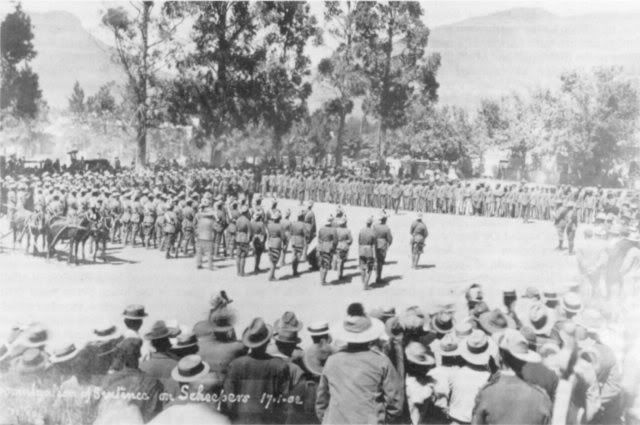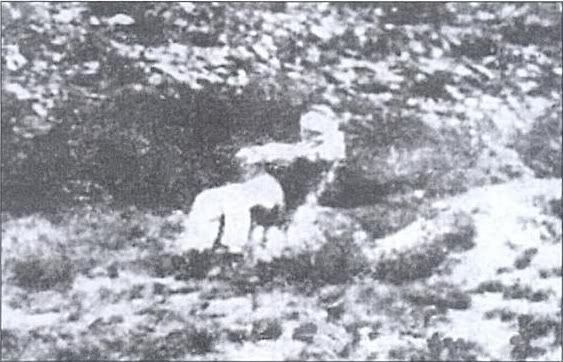After Scheepers recovered sufficiently he was taken to Noupoort and eventually to Graaff-Reinet.
Although, Scheepers was an officer of the Free State Artillery and therefore a prisoner of war, he was put on trial in Graaff-Reinet by a military court on charges of murder, arson and demolishing of trains. The arson charge was because he gave orders to burn down the farmsteads of two British sympathisers - a crime the British themselves were guilty of. In their Scorched Earth Policy they burnt down over 33 000 farmsteads in the Free State and the Transvaal, destroying all crops, orchards and livestock and in some cases even burning down village churches.
Scheepers admitted during his trial that he had committed acts of arson, but claimed that he had acted at all times on the orders of his superior officers.
He drew the court's attention to the dubious evidence laid against him by the witnesses and to the fact that he was denied the right to call his own witnesses. He also brought to notice the unfairness of the proceedings whereby all evidence heard against him was accepted as the truth, but his own testimony had been rejected, asking how he could be tried before such a prejudiced court.
He was found guilty and sentenced to death.

Promulgation of sentence on Scheepers (in white trousers, second from right in centre), 17 January 1902.
(Photo: William Roe Collection)
While waiting for his sentence to be carried out he wrote several letters to family and friends (most notably his mother) and filled his diary.
Commandant Gideon Scheepers was executed by a firing squad beside an open grave in the veld near Graaff-Reinet.

These dramatic photographs of Scheepers' execution were secretly taken by a British soldier. It later fell into the hands of MJ Leibbrandt and is the only indication of the location of Scheepers' grave. In the top photograph, he is being tied to his chair, and and in the bottom photograph, he is reeling back after the firing squad had hit their mark.

Photographs: Cape Archives
He was buried at the place of execution. However, that same night his body was apparently exhumed by British troops and reburied at an unknown spot. The grave was leveled off as you would when you bury a dog.
His execution caused an outcry in South Africa and abroad. Protests were made in the British Parliament and the United States of America, as he was not treated in accordance to the Geneva Convention. There was also a serious doubt as to whether a British military court was competent to pass a sentence of death on a prisoner of war while the war was still raging.
After the war Gideon Scheepers' mother tried desperately to get his last letters and diary, but the British refused. She wrote letters to the papers appealing to the Generals for help, as well as letters to the public prosecutor. Even though the war was over all her attempts were in vain.
Even more shameful was the British refusal to assist in the return of the body of her son who had always wanted to be buried on the family farm in Middelburg where he was born. All information were cruelly withheld and the location of Scheepers' grave is unknown to this day.
The execution has now generally been condemned by Boer and Briton as a disgraceful act. Scheepers' achievements in the war were adequate to ensure that his memory would endure, but the manner of his death elevated him to the rank of martyr.
The Gideon Scheepers Memorial near Graaff-Reinet:

A memorial to honour this Afrikaner hero was erected by the Graaff-Reinet Afrikaans Cultural Soceity. This memorial can be found approximatley 2km from the town on the Murraysburg road, on a site as near as possible to the place of execution.

The memorial comprises of three rocks from the vicinity supporting a stainless steel needle , symbolising the spirit of hope and faith in God. The largest rock represents the steadfastness of the then young Afrikaner nation. The two tilted boulders it supports symbolise this nation - suppressed but not fallen. A fourth boulder alongside bears the inscription.

There also is an Anglo-Boer War Memorial monument at the corner of Donkin and Somerset Streets in Graaff-Reinet:

It was erected "in memory of the fallen in the struggle for Freedom and Justice" - Anglo-Boer War 1899 - 1902.
The monument commemorates the eight Boers who were executed in Graaff-Reinet. The authorities refused to allow the erection of the memorial on public property. It was finally erected on private land donated by Jurie Laubscher. The design of the marble monument made in Italy, was reputedly based on photographs of Boer soldiers. It was unveiled on 2 December 1908 by General Grobler.


On 31 Mei 1999 another monument was unveiled in the Langkloof at the location of his last big battle.

An inscription at the monument quotes some of Gideon Scheepers' last words before his execution:
"Een troos het ek darem gehad, dat ek my regering tot op die laaste oomblik getrou gedien het en dat ek alles in my vermoë gedoen het om ons regverdige saak op die regte wyse te steun."
Another inscription reads:
In Middelburg se kerk staan duidelik in die doopregister sy geboorte aangemerk. En, soos waneer jy tussen vinger en die duim die wit son rol en skitter in 'n diamant, sou hy deur Vrystaat en Transvaal se leiblou ruim uit spieëls ons stryd laat blits en straal van rant tot rant. Maar hy moes sterf: Die Dood het self hom eers gejag deur kou riviere van die Kaap, dwarsoor Anysberg tot in die buitekamer op 'n plaas waar hy een nag in koue sweet moes lê. En na die skyn verhoor het hulle hom vertel... voor Graaf Reinet se sel. O Graaf Reinet se sel!
Hy was gewone kryger, Heer en geen rebel.
Uit: Gebed om die gebeente: DJ Opperman

Commandant Gideon Scheepers:
4 April 1878 - 18 January 1902
"He was an ordinary warrior, Lord and no rebel."



Sources: SA History; Antjieskraal or Blood River Station; Boer War Autographs; Karoopark; Innocent blood; Graaff Reinet
.
2 comments:
Baie interresant, die barbaarse optrede van die Britte is oor die algemeen nie bekend nie. Soveel vir Britse "fair play".
Ek is n Scheepers en volgens my Pa en my oorlede ouma Johanna Regina Scheepers getroud met Johannes Cornelius Scheepers was KMDT Gideon Scheepers familie gewees maar het altyd gedink hy was n Generaal Scheepers in Anglo-Boere Oorlog. Sal graag meer wil weet van dit
Post a Comment